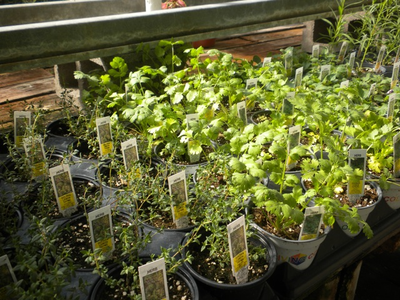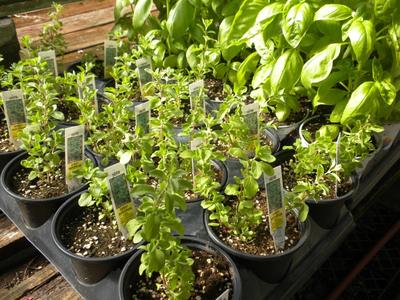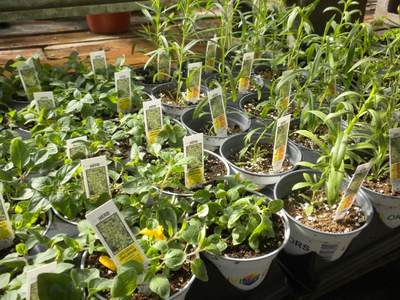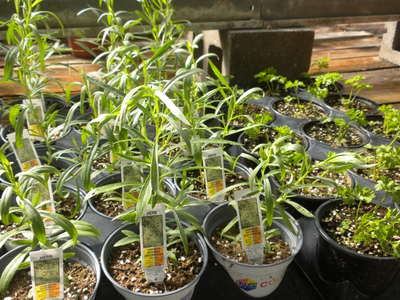Indoor Herb Garden By ferti-lome ®
By growing an indoor herb garden you can have fresh herbs year round and close at hand.
For herbs to thrive indoors they just need sunlight and regular watering, plus they look great in a window sill or a sunny corner of your kitchen! If you are new to herb gardening, start with Basil, Parsley and Chives. Other good indoor herbs are Rosemary, Cilantro, Oregano, Sage, Thyme and Mint.
What you’ll need:
How to start an indoor herb garden:
1. Select which herbs you will be growing, either plants or seeds, from your local garden center.
2. Prepare your planters or flower pots. Add a thin layer of small rocks to the bottom of the planter or pot to allow proper drainage. Mix potting soil with 20% ferti-lome Vermiculite and fill your planter or pots two-thirds full of the mixture. If starting from seeds, use small peat pots then transfer to larger pots when the plants have grown.
3. Add plants and top off with more potting mix. Gently press the potting mix down around the plant.
4. Place the planters or flower pots where they will get around six hours of sunlight a day. You can group them in one sunny window sill or spread them out in different sunny windows around your house. Avoid placing your herbs in a northern window; a western or southern window is ideal as long as you are aware of extreme heat and sun during the summer months. Use indoor fluorescent lights if necessary.
5. Water your herbs whenever the soil feels dry. Over- or under-watering herbs can kill them. Yellow leaves are a sign of over-watering. How often you need to water depends on climate, humidity and sunlight.
6. Fertilize with a standard water soluble fertilizer according to the label and repeat as suggested. We recommend ferti-lome Fish Emulsion 5-1-1 for those that like to go organic or ferti-lome Geranium, Hanging Basket & Pansy Water Soluble Plant Food 20-20-20.
7. Harvest and enjoy! To allow your herbs to thrive, never take more than half of the fresh growth. Plant more if necessary.
By growing an indoor herb garden you can have fresh herbs year round and close at hand.
For herbs to thrive indoors they just need sunlight and regular watering, plus they look great in a window sill or a sunny corner of your kitchen! If you are new to herb gardening, start with Basil, Parsley and Chives. Other good indoor herbs are Rosemary, Cilantro, Oregano, Sage, Thyme and Mint.
What you’ll need:
How to start an indoor herb garden:
1. Select which herbs you will be growing, either plants or seeds, from your local garden center.
2. Prepare your planters or flower pots. Add a thin layer of small rocks to the bottom of the planter or pot to allow proper drainage. Mix potting soil with 20% ferti-lome Vermiculite and fill your planter or pots two-thirds full of the mixture. If starting from seeds, use small peat pots then transfer to larger pots when the plants have grown.
3. Add plants and top off with more potting mix. Gently press the potting mix down around the plant.
4. Place the planters or flower pots where they will get around six hours of sunlight a day. You can group them in one sunny window sill or spread them out in different sunny windows around your house. Avoid placing your herbs in a northern window; a western or southern window is ideal as long as you are aware of extreme heat and sun during the summer months. Use indoor fluorescent lights if necessary.
5. Water your herbs whenever the soil feels dry. Over- or under-watering herbs can kill them. Yellow leaves are a sign of over-watering. How often you need to water depends on climate, humidity and sunlight.
6. Fertilize with a standard water soluble fertilizer according to the label and repeat as suggested. We recommend ferti-lome Fish Emulsion 5-1-1 for those that like to go organic or ferti-lome Geranium, Hanging Basket & Pansy Water Soluble Plant Food 20-20-20.
7. Harvest and enjoy! To allow your herbs to thrive, never take more than half of the fresh growth. Plant more if necessary.
Using Herbs as Companion Plants in Your Garden
By ferti-lome ®
Herbs work especially well as companion plants by attracting beneficial insects and repelling pest insects. Their fragrance and foliage make them a natural pest repellent in your vegetable gardens and for ornamental borders. Once you master companion planting, herb gardening takes on a whole new dimension. These are examples of companion planting in the vegetable and herb garden. Certain plants help each other thrive. Here is a brief list of herbs that are often planted near vegetables and fruits to encourage growth, deter pests, and even improve your soil. Keep in mind that these work in conjunction with your local environment and other factors that may alter the outcome.
Basil - Plant three basil plants to every tomato. Basil loves humans and animals, and would like to be your best friend in the kitchen and on the patio since it repels flies and mosquitoes.
Chamomile - Plant with onion and cabbage.
Chives - Plant near your carrots and apple trees. Chives steeped in water makes a great spray to kill powdery mildew disease.
Dill - Plant near cabbage, lettuce, corn, and cucumber. Don't plant near fennel to avoid cross pollination.
Garlic - Plant near fruit trees and tomatoes. Repels red spider mites. Great insecticide steeped in water - see "Natural and Organic Pest Control."
Geranium - Plant near corn and grapes. It's also effective against red spider mite.
Horseradish - Loves potatoes but spreads prolifically. Repels potato bugs.
Hyssop - Plant near cabbage and grapes.
Lemon Balm - Great for tomatoes.
Marjoram - Likes almost everything.
Mint - Plant near cabbage but never near parsley.
Nasturtium - Loves cole crops (collard, broccoli, cabbage, cauliflower), fruit trees, and radishes. Great insect repellent.
Oregano - Loves cole crops and grape vines. Insect repellent for cucumber beetle.
Parsley - Loves tomatoes, carrots, chives, and asparagus but cannot abide by mint.
Rosemary - Loves beans, carrots, cabbage and sage but not potatoes.
Sage - Keeps company well with rosemary, cabbage and carrots but never with cucumbers.
Summer Savory - Has been seen in the company of onions and beans.
Tarragon - Likes almost everything.
Thyme - Keeps worms away from cabbage.
By ferti-lome ®
Herbs work especially well as companion plants by attracting beneficial insects and repelling pest insects. Their fragrance and foliage make them a natural pest repellent in your vegetable gardens and for ornamental borders. Once you master companion planting, herb gardening takes on a whole new dimension. These are examples of companion planting in the vegetable and herb garden. Certain plants help each other thrive. Here is a brief list of herbs that are often planted near vegetables and fruits to encourage growth, deter pests, and even improve your soil. Keep in mind that these work in conjunction with your local environment and other factors that may alter the outcome.
Basil - Plant three basil plants to every tomato. Basil loves humans and animals, and would like to be your best friend in the kitchen and on the patio since it repels flies and mosquitoes.
Chamomile - Plant with onion and cabbage.
Chives - Plant near your carrots and apple trees. Chives steeped in water makes a great spray to kill powdery mildew disease.
Dill - Plant near cabbage, lettuce, corn, and cucumber. Don't plant near fennel to avoid cross pollination.
Garlic - Plant near fruit trees and tomatoes. Repels red spider mites. Great insecticide steeped in water - see "Natural and Organic Pest Control."
Geranium - Plant near corn and grapes. It's also effective against red spider mite.
Horseradish - Loves potatoes but spreads prolifically. Repels potato bugs.
Hyssop - Plant near cabbage and grapes.
Lemon Balm - Great for tomatoes.
Marjoram - Likes almost everything.
Mint - Plant near cabbage but never near parsley.
Nasturtium - Loves cole crops (collard, broccoli, cabbage, cauliflower), fruit trees, and radishes. Great insect repellent.
Oregano - Loves cole crops and grape vines. Insect repellent for cucumber beetle.
Parsley - Loves tomatoes, carrots, chives, and asparagus but cannot abide by mint.
Rosemary - Loves beans, carrots, cabbage and sage but not potatoes.
Sage - Keeps company well with rosemary, cabbage and carrots but never with cucumbers.
Summer Savory - Has been seen in the company of onions and beans.
Tarragon - Likes almost everything.
Thyme - Keeps worms away from cabbage.
Whartons For Every Bloomin' Thing in Western Kansas




